最新译林牛津版初中英语八年级上册Unit8Naturaldisasters公开课教学设计
- 格式:docx
- 大小:15.67 KB
- 文档页数:3
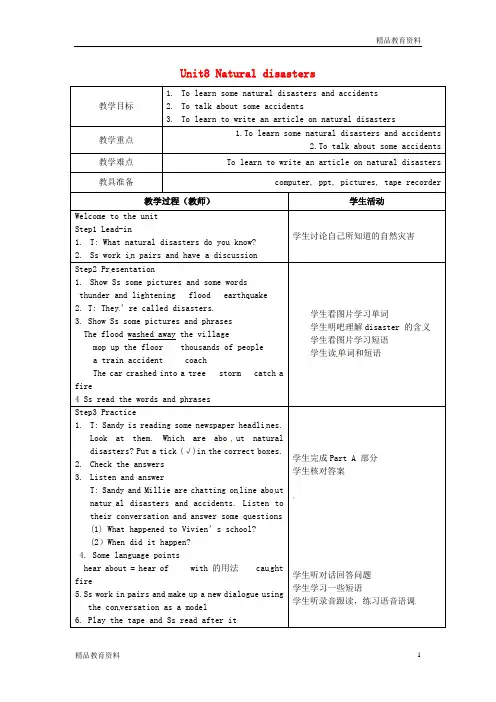
Unit8 Natural disasters教学目标1.To learn some natural disasters and accidents2.To talk about some accidents3.To learn to write an article on natural disasters教学重点1.To learn some natural disasters and accidents2.To talk about some accidents教学难点To learn to write an article on natural disasters 教具准备 computer, ppt, pictures, tape recorder 教学过程(教师)学生活动Welcome to the unitStep1 Lead-in1.T: What natural disasters do you know?2.Ss work i n pairs and have a discussion学生讨论自己所知道的自然灾害Step2 Pr esentation1.Show Ss some pictures and some wordsthunder and lightening flood earthquake2. T: They’re called disasters.3. Show Ss some pictures and phrasesThe flood washed away the vi llagemop up the floor thousands of peoplea train accident coachThe car crashed into a tree storm catch a fire4 Ss read the words and phrases 学生看图片学习单词学生明吧理解disaster 的含义学生看图片学习短语学生读单词和短语Step3 Practice1.T: Sandy is reading some newspaper headli nes.Look at them. Which are abo ut naturaldisasters? Put a tick (√)in the correct boxes.2.Check the answers3.Listen and answerT: Sandy and Millie are chatting on line abo ut natur al disasters and accidents. Listen to their conversation and answer some questions(1) What happened to Vivien’s school?(2)When did it happen?4. Some language pointshear about = hear of with 的用法 cau ght fire5.Ss work in pairs and make up a new dialogue usingthe con versation as a model6. Play the tape and Ss read after it 学生完成Part A 部分学生核对答案学生听对话回答问题学生学习一些短语学生听录音跟读,练习语音语调Comic stripStep1 Presentation1.Listen to the conversation and answer questions(1)What’s the weather like?(2)What happened to Ho bo?(3)What was Hobo doing when it started to rain?(4)Did Hobo hear the rain?(5)Why doesn’t he want to go home alone?(6)What do you think of Hobo?2.Some language pointswake up 醒来wake sb. up 叫醒某人mop up 拖干,把......拖干fall from 从……掉下,落下学生听对话回答问题学生学习相关语言点Step 2 Practice1.Act the comic strip out2. Finish some exercises on the ppt 学生表演对话学生完成ppt上的相关练习Step3 Homework1.Write an article about the natural disaster2.Review the words and phrases and some languagepoints3. Preview reading教学反思。
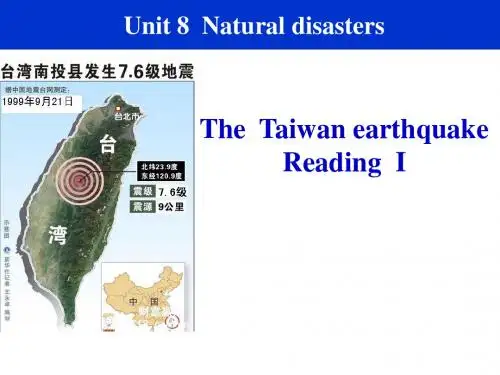
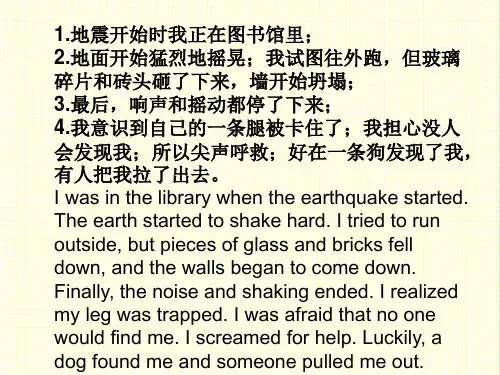
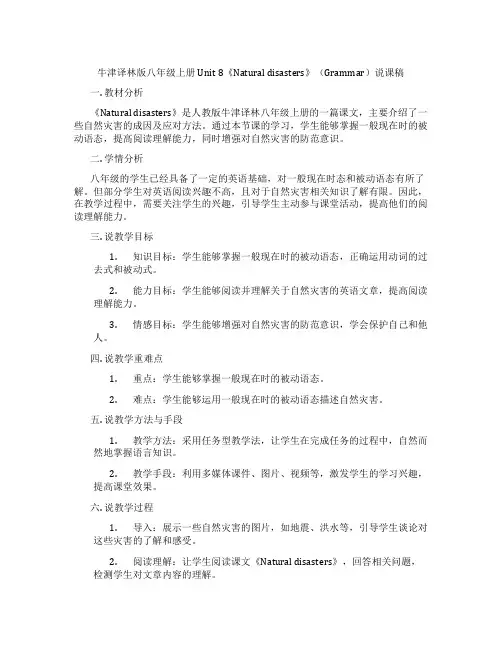
牛津译林版八年级上册Unit 8《Natural disasters》(Grammar)说课稿一. 教材分析《Natural disasters》是人教版牛津译林八年级上册的一篇课文,主要介绍了一些自然灾害的成因及应对方法。
通过本节课的学习,学生能够掌握一般现在时的被动语态,提高阅读理解能力,同时增强对自然灾害的防范意识。
二. 学情分析八年级的学生已经具备了一定的英语基础,对一般现在时态和被动语态有所了解。
但部分学生对英语阅读兴趣不高,且对于自然灾害相关知识了解有限。
因此,在教学过程中,需要关注学生的兴趣,引导学生主动参与课堂活动,提高他们的阅读理解能力。
三. 说教学目标1.知识目标:学生能够掌握一般现在时的被动语态,正确运用动词的过去式和被动式。
2.能力目标:学生能够阅读并理解关于自然灾害的英语文章,提高阅读理解能力。
3.情感目标:学生能够增强对自然灾害的防范意识,学会保护自己和他人。
四. 说教学重难点1.重点:学生能够掌握一般现在时的被动语态。
2.难点:学生能够运用一般现在时的被动语态描述自然灾害。
五. 说教学方法与手段1.教学方法:采用任务型教学法,让学生在完成任务的过程中,自然而然地掌握语言知识。
2.教学手段:利用多媒体课件、图片、视频等,激发学生的学习兴趣,提高课堂效果。
六. 说教学过程1.导入:展示一些自然灾害的图片,如地震、洪水等,引导学生谈论对这些灾害的了解和感受。
2.阅读理解:让学生阅读课文《Natural disasters》,回答相关问题,检测学生对文章内容的理解。
3.语法讲解:讲解一般现在时的被动语态,让学生通过例句和实践,掌握这一语法知识。
4.小组讨论:学生分成小组,讨论如何用英语描述一种自然灾害,以及如何防范。
5.展示与评价:每个小组选择一名代表,展示他们的讨论成果,其他同学和老师进行评价。
6.总结与反思:教师引导学生总结课堂所学,让学生反思自己在课堂上的表现,以及如何提高。
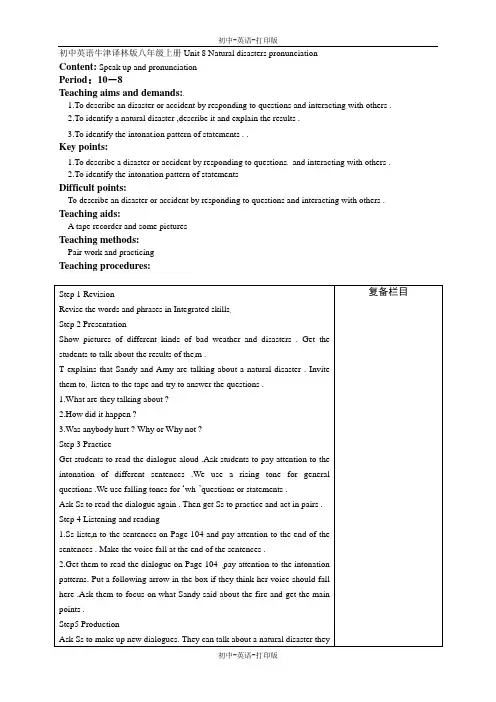
初中英语牛津译林版八年级上册Unit 8 Natural disasters pronunciationContent:Speak up and pronunciationPeriod:10-8Teaching aims and demands:1.To describe an disaster or accident by responding to questions and interacting with others .2.To identify a natural disaster ,describe it and explain the results .3.To identify the intonat ion pattern of statements . .Key points:1.To describe a disaster or accident by responding to questions and interacting with others .2.To identify the intonation pattern of statementsDifficult points:To describe an disaster or accident by responding to questions and interacting with others . Teaching aids:A tape recorder and some picturesTeaching methods:Pair work and practicingTeaching procedures:复备栏目Step 1 RevisionRevise the words and phrases in Integrated skillsStep 2 PresentationShow pictures of different kinds of bad weather and disasters . Get thestudents to talk about the results of the m .T explains that Sandy and Amy are talking about a natural disaster . Invitethem to listen to the tape and try to answer the questions .1.What are they talking about ?2.How did it happen ?3.Was anybody hurt ? Why or Why not ?Step 3 PracticeGet students to read the dialogue aloud .Ask students to pay attention to theintonation of different sentences .We use a rising tone for generalquestions .We use falling tones for ‘wh-’questions or statements .Ask Ss to read the dialogue again . Then get Ss to practice and act in pairs .Step 4 Listening and reading1.Ss liste n to the sentences on Page 104 and pay attention to the end of thesentences . Make the voice fall at the end of the sentences .2.Get them to read the dialogue on Page 104 pay attention to the intonationpatterns. Put a following arrow in the box if they think her voice should fallhere .Ask them to focus on what Sandy said about the fire and get the mainpoints .Step5 ProductionAsk Ss to make up new dialogues. They can talk about a natural disaster theykno w . Pay special attention to the intonation .Step 6 Homework1.Read the dialogues in correct intonation .2.Finish off more exercises.3.Preview Main task: find the new phrases and try to re member them.教学反思:达标检测Unit 6 Speak up and pronunciation (30’)一、用所给的汉语或英语单词的适当形式填空(9’)1.He felt cold and ___________ (frighten ), but he couldn’t move .2.They sent the __________ (受害者) to the hospital at once .3.The snowstorm started again in the afternoon and it got ______ (bad) later .4.Mrs Su hurt her leg but it was not _________ (严重的).5.The snow was heavy and it _______ (覆盖)everything .6.This morning I read a newspaper article about a car ________ (事故).7.I was surprised to see that my pet dog was still _____ (live) after the earthquake .8.The number of the _____________ (survive) of the Titanic was less than eight hundred .9.Pe ople ran in all _______ (direct) when they heard the sudden gun .二、用正确的语音和语调朗读下列句子(8’)1. Did you hear about the flood in Wuhan last month ?2. Were you alone in the car ?3.When will they arrive in Beijing ?4.How much does the baby mouse weigh ?5.Who is the busiest in your family ?6.There was water all round her house .7.He and his family moved his uncle’s house8.The whole road was covered with snow and we couldn’t get out .三、用所给动词的适当形式填空(13’)1.Who is ________ (mop) up the f loor ? It’s so clean .2.It’s unlucky ______ (lose)the game or get ______(lose) in a new city .3.We should try our best ________ (prevent) the sand from _______ (come) to the good farmland in the south .4.Timmy ________ (trap) in a dark place when the earthquake _______ (stop) .5.The radio says that the temperature __________ (drop)a little tomorrow .6.When they _______ (hear)the big noise like thunder ,they ______ (tell) themselves _______ (keep) calm .7.The firemen________ ( put) out the fire soon .8.Bad weather ________ (cause) natural disaster .。
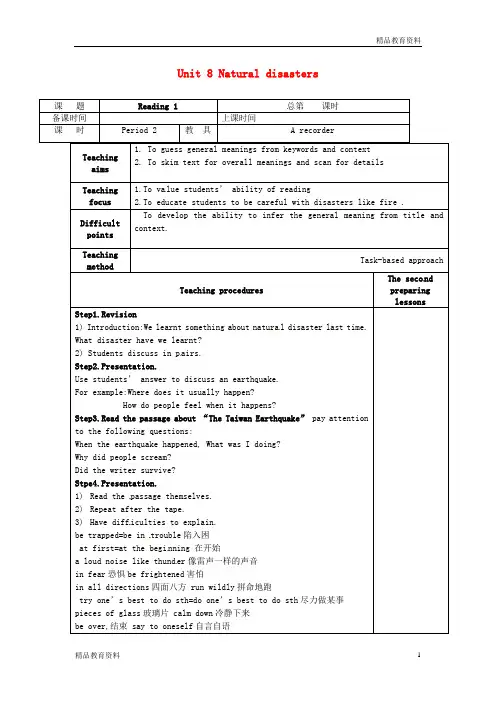
Unit 8 Natural disastersTeachingaims 1. To guess general meanings from keywords and context 2. To skim text for overall meanings and scan for detailsTeaching focus 1.To va lue students ’ ability of reading2.To educate students to be careful with disasters like fire .Difficult points To develop the ability to infer the general meaning from title and context.Teaching methodbased approach-Task Teaching proceduresThe seco nd preparing lessonsStep1.Revision1) Introduction:We learnt something about natura l disaster last time. What disaster have we learnt? 2) Students discuss in p airs. Step2.Presentation.Use students ’ answer to discuss an earthquake. For example:Where does it usually happen?How do people feel when it happens?Step3.Read the passage about “The Taiwan Earthquake ” pay attention to the following questions:When the earthquake happened, What was I doing? Why did people scream? Did the writer survive? Stpe4.Presentation.1) Read the passage themselves. 2) Repeat after the tape.3) Have diff iculties to explain. be trapped=be in trouble 陷入困 at first=at the begi nning 在开始a loud noise like thund er 像雷声一样的声音 in fear 恐惧be frightened 害怕in all directions 四面八方 run wildly 拼命地跑try one ’s best to do sth=do one ’s best to do sth 尽力做某事 pieces of glass 玻璃片 calm down 冷静下来 be over,结束 say to oneself 自言自语课 题 Reading 1总第 课时 备课时间 上课时间课 时Period 2 教 具A recordershout for help喊救命in a great hur ry急匆匆move away搬look at each other in fear恐惧地对看着do some shopping买东西 stay alive活着 go through my mind闪过头脑Sentences: I was doing my homework when it started.I didn’t know if anyone was around me.I didn’t know where I was.Some people screamed because they were very frightened.People were runn ing wildly while pieces of glass and brickswere falling down.They didn’t know where to go.Some people ran out of the shopping centre.I thought somebody could hear me but no one came for a longtime.I was trying to find my way out when I suddenly heared somenoise above me.Step5.Consolidation.1).Read the passage again.2).Give students some key words, and ask them to retell the story if time permitted.Step6.Home work:Teachingnotes。
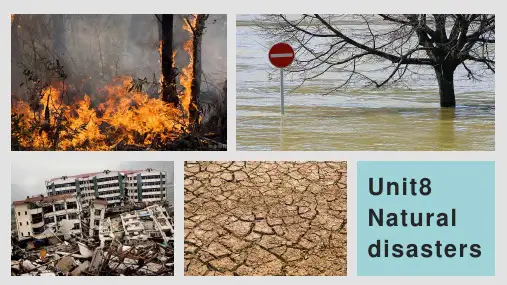
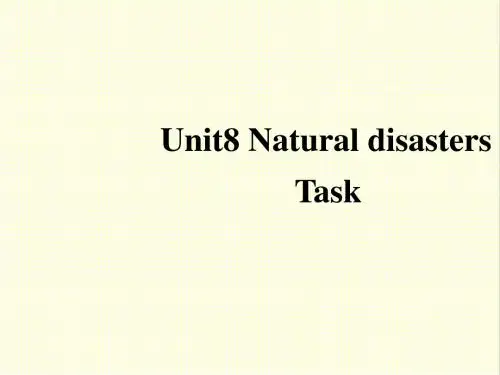
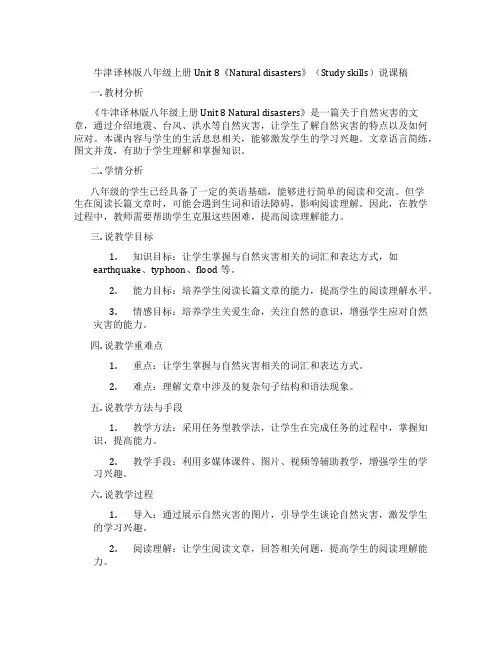
牛津译林版八年级上册Unit 8《Natural disasters》(Study skills)说课稿一. 教材分析《牛津译林版八年级上册Unit 8 Natural disasters》是一篇关于自然灾害的文章,通过介绍地震、台风、洪水等自然灾害,让学生了解自然灾害的特点以及如何应对。
本课内容与学生的生活息息相关,能够激发学生的学习兴趣。
文章语言简练,图文并茂,有助于学生理解和掌握知识。
二. 学情分析八年级的学生已经具备了一定的英语基础,能够进行简单的阅读和交流。
但学生在阅读长篇文章时,可能会遇到生词和语法障碍,影响阅读理解。
因此,在教学过程中,教师需要帮助学生克服这些困难,提高阅读理解能力。
三. 说教学目标1.知识目标:让学生掌握与自然灾害相关的词汇和表达方式,如earthquake、typhoon、flood等。
2.能力目标:培养学生阅读长篇文章的能力,提高学生的阅读理解水平。
3.情感目标:培养学生关爱生命,关注自然的意识,增强学生应对自然灾害的能力。
四. 说教学重难点1.重点:让学生掌握与自然灾害相关的词汇和表达方式。
2.难点:理解文章中涉及的复杂句子结构和语法现象。
五. 说教学方法与手段1.教学方法:采用任务型教学法,让学生在完成任务的过程中,掌握知识,提高能力。
2.教学手段:利用多媒体课件、图片、视频等辅助教学,增强学生的学习兴趣。
六. 说教学过程1.导入:通过展示自然灾害的图片,引导学生谈论自然灾害,激发学生的学习兴趣。
2.阅读理解:让学生阅读文章,回答相关问题,提高学生的阅读理解能力。
3.词汇学习:讲解文章中出现的生词和短语,让学生掌握与自然灾害相关的词汇。
4.语法讲解:分析文章中的复杂句子结构和语法现象,帮助学生理解。
5.小组讨论:让学生分小组讨论如何应对自然灾害,培养学生的合作意识。
6.总结:对本节课的内容进行总结,强化学生的记忆。
7.作业布置:让学生课后写一篇关于自然灾害的短文,提高学生的写作能力。
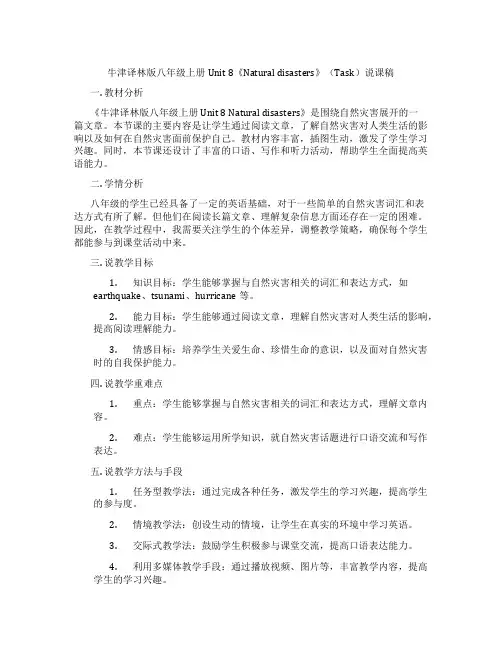
牛津译林版八年级上册Unit 8《Natural disasters》(Task)说课稿一. 教材分析《牛津译林版八年级上册Unit 8 Natural disasters》是围绕自然灾害展开的一篇文章。
本节课的主要内容是让学生通过阅读文章,了解自然灾害对人类生活的影响以及如何在自然灾害面前保护自己。
教材内容丰富,插图生动,激发了学生学习兴趣。
同时,本节课还设计了丰富的口语、写作和听力活动,帮助学生全面提高英语能力。
二. 学情分析八年级的学生已经具备了一定的英语基础,对于一些简单的自然灾害词汇和表达方式有所了解。
但他们在阅读长篇文章、理解复杂信息方面还存在一定的困难。
因此,在教学过程中,我需要关注学生的个体差异,调整教学策略,确保每个学生都能参与到课堂活动中来。
三. 说教学目标1.知识目标:学生能够掌握与自然灾害相关的词汇和表达方式,如earthquake、tsunami、hurricane等。
2.能力目标:学生能够通过阅读文章,理解自然灾害对人类生活的影响,提高阅读理解能力。
3.情感目标:培养学生关爱生命、珍惜生命的意识,以及面对自然灾害时的自我保护能力。
四. 说教学重难点1.重点:学生能够掌握与自然灾害相关的词汇和表达方式,理解文章内容。
2.难点:学生能够运用所学知识,就自然灾害话题进行口语交流和写作表达。
五. 说教学方法与手段1.任务型教学法:通过完成各种任务,激发学生的学习兴趣,提高学生的参与度。
2.情境教学法:创设生动的情境,让学生在真实的环境中学习英语。
3.交际式教学法:鼓励学生积极参与课堂交流,提高口语表达能力。
4.利用多媒体教学手段:通过播放视频、图片等,丰富教学内容,提高学生的学习兴趣。
六. 说教学过程1.导入:以一段关于自然灾害的视频导入,激发学生的学习兴趣。
2.阅读理解:学生阅读文章,回答相关问题,了解自然灾害对人类生活的影响。
3.词汇学习:学生通过小组合作,归纳总结文章中出现的自然灾害词汇。
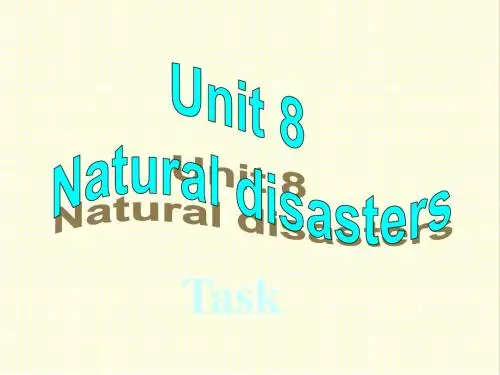
Unit 8 Natural disasters重难点精讲It’s raining. My house is all wet.句中 all wet 是“湿透”的意思,还有“大错特错”的意思。
题一:翻译:我全身都湿透了,我可以进来吗?如果你认为我喜欢你的话,你就大错特错了。
Lightning hit a classroom building and it caught fire.句中的hit是“打击、危害”的意思。
短语catch fire的意思是“烧着,着火”。
make a fire/light a fire 生火set a fire 放火题二:翻译:我扔了一块橡皮,砸到了他的头上。
没有人知道森林是如何着火的。
People screamed in fear.句中的fear表示“害怕、恐惧、担忧”。
fear sb. 与 fear for sb.前者意为害怕某人,后者意为为某人担心。
in fear of 表示“害怕、担心”。
题三:翻译:他怕他老婆。
他为他老婆担心。
我们担心会再下雪。
Outside, people were running in all directions while pieces of glass and bricks were falling down.句中的while是一个连词,连接两个并列句,表示“对比”关系。
in all directions 四面八方题四:翻译:我喜欢唱歌,而她喜欢跳舞。
他出去散步了,而我却呆在家里。
学生们从四面八方地跑进了教室。
A moment of fear went through my mind, but I told myself to calm down since I was still alive.句中的fear是______,是“______”的意思。
go through有“通过、检查”的意思。
calm down, relax, cool down题五:翻译:你现在害怕回到你自己的国家吗?他正处于非常艰难的时期。
牛津译林版八年级上册Unit 8《Natural disasters》(Task)教学设计一. 教材分析牛津译林版八年级上册Unit 8《Natural disasters》主要介绍了自然灾害,包括地震、洪水、台风等,通过学习本单元,学生可以掌握有关自然灾害的词汇和表达方式,了解自然灾害发生的原因及应对措施。
Task部分要求学生阅读一篇关于自然灾害的文章,然后进行相关练习,培养学生的阅读能力和解决问题的能力。
二. 学情分析八年级的学生已经具备了一定的英语基础,能够进行简单的阅读和交流。
但部分学生在阅读长篇文章时,可能会遇到生词和语法难题,影响阅读理解。
此外,学生对于自然灾害的了解程度不一,需要教师在教学中进行引导和补充。
三. 教学目标1.知识目标:学生能够掌握有关自然灾害的词汇和表达方式,了解自然灾害发生的原因及应对措施。
2.能力目标:学生能够阅读并理解关于自然灾害的文章,提高阅读能力;通过任务型教学,培养学生的解决问题能力。
3.情感目标:培养学生关爱生命,关注自然的意识,提高学生应对自然灾害的能力。
四. 教学重难点1.重点:学生能够掌握有关自然灾害的词汇和表达方式,阅读并理解关于自然灾害的文章。
2.难点:学生能够运用所学知识,解决实际问题,提高应对自然灾害的能力。
五. 教学方法1.任务型教学法:通过任务型教学,让学生在实践中掌握知识,提高能力。
2.情境教学法:创设情境,让学生在真实的环境中学习,提高学生的学习兴趣。
3.合作学习法:引导学生进行小组合作,培养学生的团队精神和沟通能力。
六. 教学准备1.教师准备:提前准备关于自然灾害的文章,整理相关词汇和表达方式,设计任务型练习。
2.学生准备:预习课文,了解自然灾害的基本知识,准备参与课堂活动。
七. 教学过程1.导入(5分钟)教师通过提问方式引导学生谈论自然灾害,激发学生的学习兴趣。
例如:“你们知道哪些自然灾害?它们发生的原因是什么?”2.呈现(10分钟)教师呈现关于自然灾害的文章,让学生快速阅读,了解文章大意。
新版牛津版八年级英语上册Unit8Naturaldisasters 词汇与语法基础训练含答案一、必背词汇disaster n. 灾难;不幸,祸患 mop vt. 用拖把擦干净 up adv. 完全地 earthquake n. 地震 accident n. 事故,意外的事 coach n. 长途汽车crash vi. & vt. 猛撞;碰撞 flood n. 洪水,水灾 village n. 村庄,乡村 lightning n. 闪电 storm n. 风暴,暴(风)雨 thunder n. 雷,雷声 slight adj. 轻微的 shake vi. & vt. 摇动,震动 loud adj. 响亮的;大声的;喧闹的 bomb n. 炸弹 fear n. 害怕,恐惧Unit 8 Natural disasters知识精讲direction n. 方向brick n. 砖,砖块silent adj. 寂静的nervous adj. 紧张不安的heart n. 心脏beat vi. & vt. (使)规律作响,作节奏运动trapped adj. 困住的mind n. 头脑calm vi. & vt. (使)平静,(使)镇定since conj. 由于,既然still adv. 仍然alive adj. 活着的dark n. 黑暗shout n. 呼喊,喊叫声safe adj. 安全的asleep adj. 睡着的break vi. 损坏;打破towel n. 毛巾,浴巾rule n. 规则railway n. 铁路pancake n. 烙饼,薄饼burn n. 烧伤,烫伤,灼伤board n. 木板headache n. 头痛toothache n. 牙痛countryside n. 乡下, 农村nearly adv. 几乎,将近clear vt. 清除,清理shaking n. 摇动,震动二、重点词汇1. break verb /breɪk/1). to (cause something to) separate suddenly or violently into two or morepieces, or to (cause something to) stop working by being damaged 破碎,破裂;打破;打断;损坏,弄坏例句:The dish fell to the floor and broke.碟子掉到地上摔碎了。
Unit 8 Reading【Analysis of teaching material】The Two reading paragraphs are excerpted from Robinson Crusoe which is written by Daniel Defoe and introduces Robinson’s youth and the time up to his shipwreck, his 28 years on an uninhabited island,his life and adventures after being rescued from the island.The first paragraph is about Robinson’s life and inner his feeling after he first arrived on the island, and the second paragraph mainly talks about the story between Robinson and Friday.【Teaching aims】1.Students master some key words and phrases.2.Students can improve their reading skills of scanning and skimming.3.Students can understand the present perfect tense in the passage4.Students can have awareness of never giving up in the face of difficulties.【Teaching key and difficult points】1.To improve students’ reading skills of skimming and scanning.2.To understand the present perfect tense in the passage.【Teaching method】3P【Teaching procedures】Step1: Lead-in1.Daily greeting to students.2.Check the homework3.Watch a short video and imagine what you will do if you are left alone on theisland? Wait for death or find ways to survive?4.What would you prepare to deal with the problems?Step2: Pre-readingLook at the picture, what can you know from the picture?Step3: Fast-readingRead and match the main idea with each paragraphStep 3: Careful reading1.Imagine what problems you may have if you were left alone on the island just like Robinson?2.Read para.1 and find what Robinson has done to deal with the problems?3.Read Para. 2 and complete the timelineStep 4: After reading1.What do you think of Robinson Crusoe?Robonsin is brave, creative, clever, optimistic and he is a ma full of wisdom and courage.2.What can we learn from Robinson Crusoe?●Never give up trying in the face of difficulties.●There are more ways than difficulties.●Learn the importance of life skillsLife is fine, and learn to enjoy it.3.Is there anyone who has the same spirit as Robinson?4.Robinson and Friday lived on the island for 28 years. Finally, they were saved by a ship passing by. Can you make up your end to the story?【Homework】Level 1:Tell the story of Robinson Crusoe to your friends after class.Level 2: Try to go on writing your own story of Robinson and share your story with us next class.【Blackboard design 】【Teaching reflection】In this reading class,individual learning and group cooperation are combined to promote to improve students’ reading skills, and in some ways stimulate learning motivation of students. However, as the reading passages in grade 8 are becoming more and more difficult,some students still don’t have the habit of previewing, so they can’t finish the reading tasks within limited time. Besides, some students are not able to understand the present perfect tense in the passage. Last but not least, the text analysis is not enough.。
最新译林牛津版初中英语八年级上册Unit8Naturaldisasters
公开课教学设计
Natural disasters
第一课时 Welcome to the unit
Teaching aims:
To introduce the top ic of disaters.
To identify vocabulary related to disasters.
To identify weather conditions and label pictures with correct words.
Focus and difficulties: To recognize the weather conditions and natural disaster.
Teaching methods:
Communication and description
Teacing aids: recorder Multi-media computer
Teaching procedures:
Step1 Lead in :
T: What’s the weather like today?
Ss: It …
Revise some other words about weather.e.g. rain, snow, wind.…
Step2 Presentation
1.Show some pictures of snowstorm that happened inChina during last Spring Festival .Get them to answer the questions abo ut it.
﹙1﹚.Do you like snow in winter?
﹙2﹚.Do you think too much snow is good or bad for people?
2.Encourage students to tell their ideas.
Show more pictures of bad weather.
Ask: What caused the trouble or problems?
Help students to answer : nature. They a re natural disasters.They cause
the bad weather .They make people get into the trouble.
Step3 Practice
1.T: Do you know what other natural disasters ? What words do we use to talk about bad weather ?
Elicit from students other bad weather conditions. ( rainstorm, snow storm,typhoon.e.g.)
2. Read the words in Part B and ask more able students to describe each weather condition only with simple phrases and words.
3. Help Ss to complete the task on their own and c heck the correct answers with the class as a whole.
4.Show more pictures of natural disasters,help students to know their names and describle them. Help students to use the Past Continuous Tense to talk about the pictures.
5.T: Can you distinguish natural disasters from disasters caused by other reasons?Get them to look at part A on P93 and try to finish this part check the correct answers with the class as a whole,then read together. Teach some new words.
Step4 Activity
Divide the students into groups of four to discuss. Bring some photos to each group and ask students to write a headline about natural disasters or accidents.
Step5 Presentation
1.T: Look at the pictures ,people suffered from these natural disasters . What can we do to help them.Students will discuss it warmly. Then teacher leads students to the comic strip.
2.T:Hobo has some trouble. What happened to him? Let’s have a look. Students look at the pictures. Teacher asks some
open questions about each picture.
1).What’s the weather like?( It’s raining)
2). What happened to Hobo?( He got wet.)。